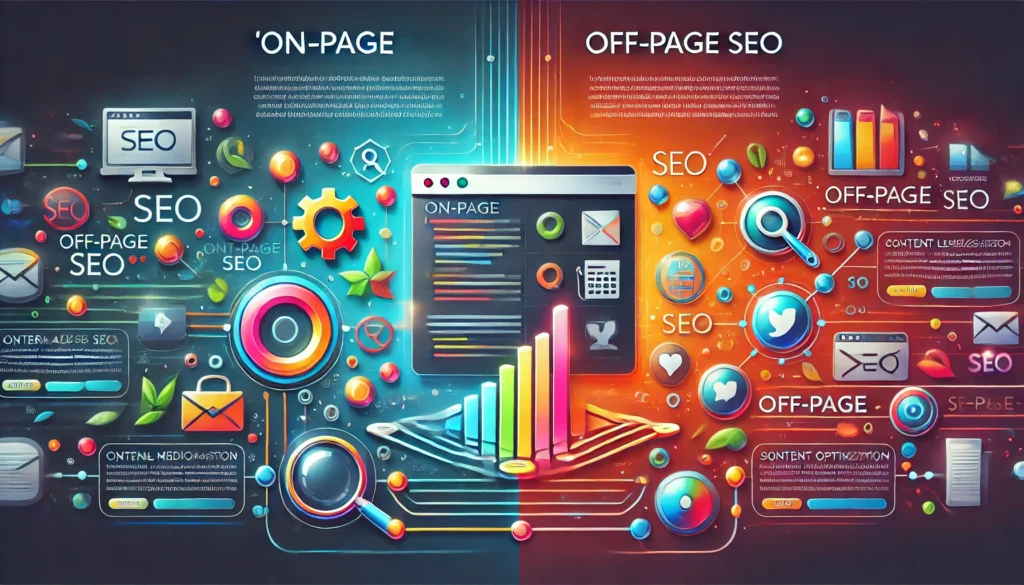On Page and Off Page SEO: Essential Strategies for 2024

To achieve higher rankings on Google and maximize your website’s visibility, mastering on page and off page SEO is crucial. Both on-page SEO and off-page SEO play unique roles in search engine optimization, but they’re interconnected in driving organic traffic and improving search rankings.
At JLTechs, we specialize in combining these two pillars of SEO to offer a comprehensive solution for businesses aiming to enhance their online presence. In this blog, we’ll take an in-depth look at on-site and off-site SEO, discuss why both are necessary, and explore actionable strategies for optimizing each. We’ll also share how you can leverage them for better results, and how JLTechs can help you achieve success.
What is On Page SEO?
On-site SEO refers to the set of strategies and techniques used to optimize the content and structure of your website to rank higher on search engine results pages (SERPs). It focuses on everything within your website, including content, HTML code, and technical aspects that directly influence your search rankings.
Key Elements of On Page SEO
Let’s break down the major components of on-site SEO and how they help improve your rankings:
-
- High-Quality Content
At the core of on-site SEO is content. Search engines like Google rank content based on its relevance, quality, and ability to provide value to the user. To create SEO-friendly content, keep the following points in mind:
-
- Keyword Optimization: Use relevant keywords that your audience is likely to search for. These keywords should appear naturally within your content, especially in titles, headers, and body paragraphs. However, avoid keyword stuffing, as it can hurt your rankings.
-
- Answer Search Intent: Your content should address the intent behind users’ queries. Make sure to provide clear, concise, and actionable answers to what people are searching for.
-
- Content Length: While short articles may be easier to read, longer, more in-depth content tends to rank higher on Google. Aim for comprehensive articles that cover topics thoroughly while staying relevant to your audience.
-
- Meta Tags Optimization
Meta tags are essential for telling search engines what your page is about. They include:
-
- Title Tags: Your title tag should contain the focus keyphrase (in this case, on-site and off-site SEO) and should be compelling enough to encourage users to click on your website when it appears in search results.
-
- Meta Descriptions: A meta description is a brief summary of the page’s content that appears below the title tag in search results. It should be concise, descriptive, and contain your focus keyphrase. This can significantly improve your click-through rate (CTR).
-
- Headings and Subheadings (H1, H2, H3)
Using appropriate headings and subheadings is another vital part of on-site SEO. These HTML tags help organize your content and make it easier for search engines to crawl and understand the structure of your page. Make sure to use your target keyphrase and its synonyms in your headings where relevant.
-
- URL Structure
Your URLs should be short, descriptive, and include the primary keyword for the page. Clean, keyword-rich URLs help both search engines and users understand the content of your page before they even click on it. For instance, a URL like “www.jltechs.com/on-page-and-off-page-seo” is more user-friendly and SEO-friendly than a complex, random string of numbers and characters.
-
- Internal Linking
Internal links connect different pages within your website. They help users navigate your site more easily and indicate to search engines which pages are important. For example, linking to relevant pages, like our blog on boosting your site’s Google search visibility, not only improves user experience but also boosts SEO.
-
- Mobile-Friendliness
With the rise in mobile users, having a mobile-friendly website is non-negotiable for good rankings. Google uses mobile-first indexing, meaning it primarily uses the mobile version of a website for ranking and indexing. Ensuring that your site is responsive and works well across all devices is critical for on-site SEO.
-
- Page Speed
Page load speed is a crucial ranking factor. A slow website can negatively affect user experience, causing visitors to leave your site before it even loads fully. Use tools like Google PageSpeed Insights to check your website’s speed and optimize images, leverage browser caching, and reduce unnecessary plugins to improve load times.
-
- Image Optimization
Images enhance your content and improve engagement, but they need to be optimized for SEO. Use descriptive file names and add alt text that includes relevant keywords to help search engines understand the content of your images. Additionally, compressing images can significantly improve load speed, which positively impacts SEO.
What is Off Page SEO?
While on-site SEO focuses on optimizing elements within your website, off-site SEO is about improving your website’s authority, relevance, and trustworthiness by building connections and gaining recognition from external sources. Off-site strategies help search engines understand how valuable your website is to the online community.
Key Components of Off Page SEO
Let’s explore some effective off-site SEO strategies:
-
- Building High-Quality Backlinks
Backlinks, also known as inbound links, are links from other websites to your site. Google considers backlinks as a vote of confidence, and the more authoritative the site linking to you, the more trust and authority you gain in Google’s eyes.
-
- Social Media Marketing
Social media platforms provide excellent opportunities to promote your content, build brand awareness, and engage with your audience. While social media signals aren’t a direct ranking factor, having a strong presence can lead to more backlinks, traffic, and user engagement, which benefits off-site SEO indirectly.
-
- Local SEO and Google My Business
For businesses targeting local customers, local SEO is essential. Claiming and optimizing your Google My Business profile is a must. It helps you appear in local searches and maps, increasing your visibility to potential customers.
-
- Brand Mentions
Even without a direct link, brand mentions across the web can impact your SEO. When your brand is discussed in a positive light, it enhances your authority and reputation in the eyes of search engines.
-
- Influencer Marketing
Collaborating with influencers in your industry can significantly boost your off-site SEO. Influencers can help promote your brand, leading to more backlinks, traffic, and brand recognition.
Why You Need Both On Page and Off Page SEO
A successful SEO strategy relies on both on-site and off-site efforts working together. While on-site SEO ensures that your content is optimized for search engines, off-site SEO builds the authority of your site, making it more likely to rank for competitive keywords.
How JLTechs Can Help with SEO
At JLTechs, we specialize in comprehensive SEO strategies covering both on page and off page seo. Whether you need to optimize your website or build high-quality backlinks, we’re here to help you achieve your digital marketing goals. Our expert team tailors strategies to align with your business needs and drive measurable results. Contact us today to learn how we can enhance your Google ranking and increase traffic to your business.
Conclusion
Understanding on page and off page seo is crucial for a well-rounded digital marketing strategy. Both are essential for improving your search engine ranking and driving traffic to your site. By focusing on optimizing your website and building a strong off-site reputation, you can ensure long-term SEO success.
For more information on SEO, feel free to explore Wikipedia’s SEO page.e.SEO page.

